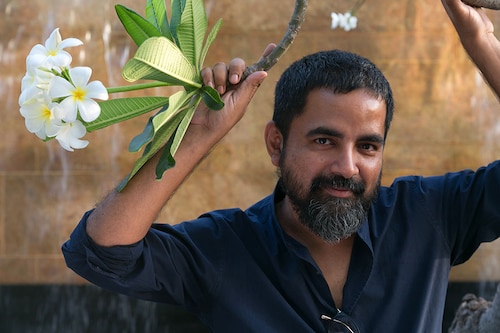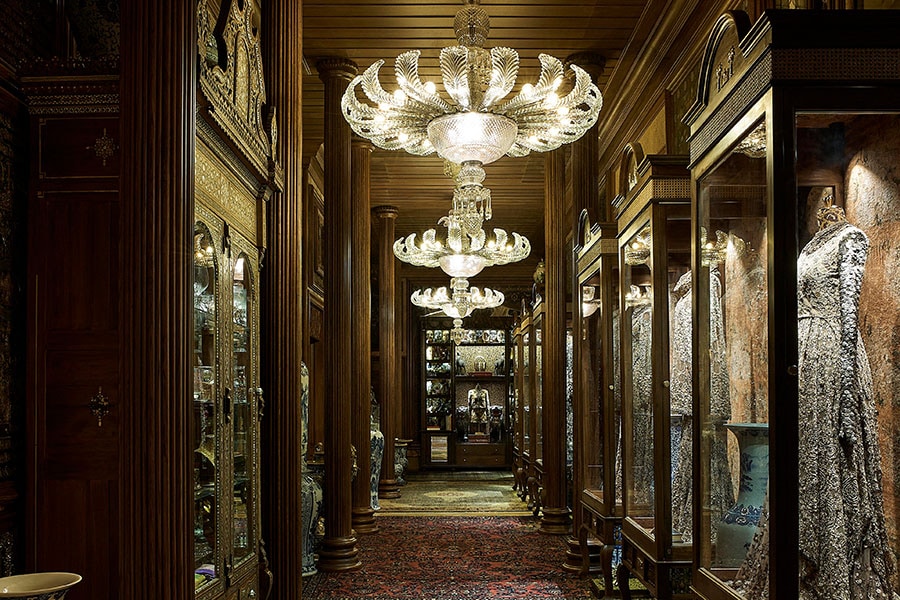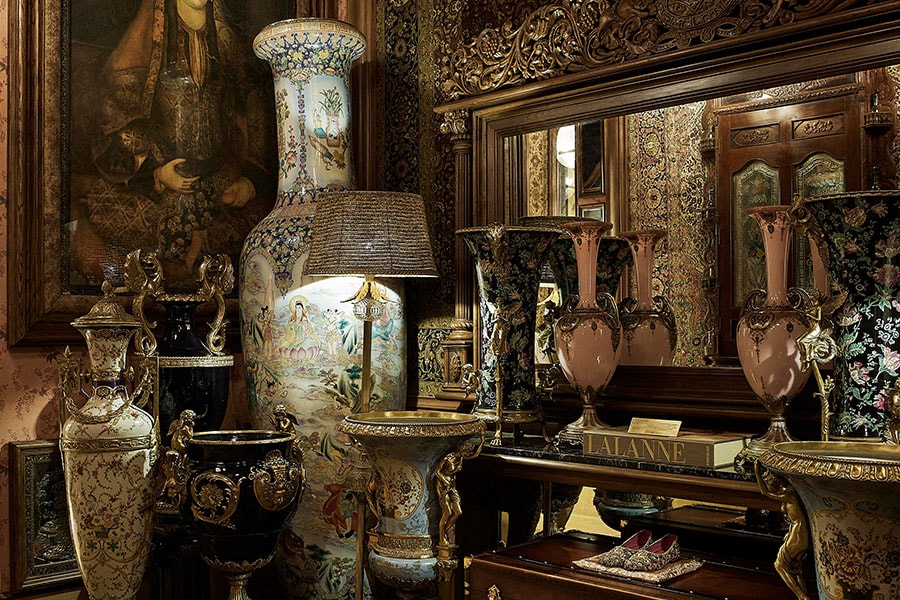I want to deliver to India its first luxury super-brand: Sabyasachi Mukherjee
The fashion designer and businessman talks about his new flagship store, building a global luxury brand and his plans for the next 15-20 years


‘For culture to be relevant it needs to be dynamic’
These words are embellished on a brass panel, one of many such panels that are dotted all over the store along with leather-bound books and rare canton vases at the new Sabyasachi store in Mumbai. The brand has always been about luxury, but the experience at this flagship store at Horniman Circle, sprawled over 25,862 sq ft, takes it a notch higher. Every corner is pure opulence—be it the rare French art nouveau cabinets, the 100 grand chandeliers or the exquisitely curated carpets and paintings. Mukherjee wanted the store to be “an immersive retail space that merges the house’s signature cultural savoir faire with Indian decadence, craftsmanship and history". The tiniest nook of this “living museum" reflects all that Sabyasachi Mukherjee, the man behind the brand, stands for.
Mukherjee says, “I know what the rumours must be… Birla money, indulgence, flex. But none of this is true. This store came out of necessity, we are expanding fast." The brand Sabyasachi has now expanded into jewellery, handbags, belts and many more accessories. Then, in 2021, Aditya Birla Fashion and Retail Ltd (ABFRL) acquired 51 percent stake in the Indian luxury designer label. Mukherjee calls himself a businessman first, and then a fashion designer. He says: “Business is not really about a product, it is about understanding a human being. You just need to have general empathy, a little bit of humility and a little bit of wisdom to be able to do that."
Since debuting as a fashion designer in 1999, Mukherjee has created a global brand, with many global collaborations with brands such as Christian Louboutin and Bergdorf Goodman and the launch of their New York store. In a free-flowing conversation with Forbes India, Mukherjee talks about professionalising the brand and his expansion plans. Edited excerpts:
Q. The Sabyasachi experience keeps getting bigger. How do you continuously manage to stay ahead of the curve?
I can keep myself relevant by making sure that I"m surrounded by people who are not from fashion and by not taking myself too seriously. I"m relevant because I"m irrelevant. Every five or ten years, I change my retail strategy to make it future-proof.
Hermà¨s is one of the top luxury brands in the world, particularly in terms of reverence. Recently, the brand opened a new flagship store at Madison Avenue in New York. They didn’t do it for the “business", they’re doing it to build reverence for the next 20 years.
Brands need to decide if they are offline or online businesses. If you decide to do both, then how are you going to differentiate between them? If you want to create an offline business, then you need to create an experiential store, otherwise why would people come to the store and buy?
I keep telling brands that if you are becoming very profitable, and not investing in the next phase of your business, that means you are not investing correctly. I believe in staying ahead of the game and giving back to a consumer.
 Sabyasachi New Flagship Store - Mumbai Credits: Interiors and overall creative direction: Sabyasachi Mukherjee Photography: Bjà¶rn Wallander
Sabyasachi New Flagship Store - Mumbai Credits: Interiors and overall creative direction: Sabyasachi Mukherjee Photography: Bjà¶rn Wallander
Q. As a luxury brand the “experience" is just as important as the product. Why is this?
In the luxury business, you can improve a product till it reaches a saturation point, beyond that you cannot render it any better. But you can increase the brand experience infinitely. When you do that, customers are willing to pay more as well.
Every year I ask myself two questions: What is it that I’m giving back to the community that works with me and how am I creating better value for my customer? A customer is going to come to buy the same Banarasi sari or the same red lehenga. But can I give them better packaging? Serve them better tea? Give them a better atmosphere so that it becomes an unforgettable experience? Teach my sales staff the virtue of politeness, so that you are not condescending to a customer who only wants to come and experience? Luxury to me is multidimensional. You have to make sure that you create better value propositions for your customer.
A lot of people would look at this store and they would say it"s a gamble. It"s not. It"s a very methodical investment… I don’t gamble. I don"t have the moral compass to gamble. It’s not in my DNA. I might be spending a lot of money, but I spend it with complete conviction that it is the right way to invest for me.
Q. You call yourself a businessman first, and then a fashion designer. How do you balance the two?
It was never difficult for me, maybe it is a gift. But there used to be a time when listening to my customer’s perspective was important and I had to ignore my own perspective. There were certain products that we didn’t want to do, but it was important to be able to make money and fuel growth.
But when the brand becomes influential, the customer learns to listen to your voice. Once you meet that holy trinity of customer reverence, idealism and profit… then you grow that into a very robust and sustainable business.
So right now, with Sabyasachi I"m creating products that I would like to buy from the brand, not just looking at the customer point of view, and it’s a fulfilling journey. It takes a lot of hard work, persistence and consistency to get there. Today, we can dictate to our customer exactly what we want to sell and we sell it at our own terms. We create value in a very multidimensional way for our customers. Sometimes running a fashion label feels like running a lifestyle and hospitality brand—you have to deliver at multiple levels, not just at the product level.
Q. You recently launched your first international flagship store in New York. What motivated that decision?
Frustration and anger. I don’t like the way India is represented internationally. I think that we have done a great disservice to this country by not representing it right. For me, the representation matters. I get very upset at the fact that people think that we have to be at Queens or we have to be at Bronx and run an Indian luxury store out of a garage.
Indian customers are thrilled with joy looking at the New York store. Even if I can make the tiniest contribution in helping Indians create reverence about their own heritage, I think it"s a job well done and I can rest in peace. At the same time, the Western customer is completely in shock. They don’t expect India to do this kind of ‘flex’ as you call it.
For me New York was a flex, to show the Western people that please don’t put India in a corner. You have no idea what the country is. The idea that India is a country that produces cheap products and there’s cheap labour, no quality and we don’t have consistency we don’t have what it takes to build a luxury brand... I wanted to silence that once and for all.
 Sabyasachi New Flagship Store - Mumbai Credits: Interiors and overall creative direction: Sabyasachi Mukherjee Photography: Bjà¶rn Wallander
Sabyasachi New Flagship Store - Mumbai Credits: Interiors and overall creative direction: Sabyasachi Mukherjee Photography: Bjà¶rn Wallander
Q. What was the thought process behind the strategic investment that Sabyasachi got from Aditya Birla Fashion?
I don’t have children and nobody in my family is interested in business. Many designers are of the belief that “the brand will die with us". But I don’t believe that. You cannot create something that you give to the customer, and then retract it.
I am a man who simply shares the name with the brand—that’s where the commonality ends. Sure I built the brand, but today, it is a separate person, it’s not me. I don"t even dress like the brand—we are as disparate as disparate could be.
When you create something like this, you understand that the ownership of the brand does not lie with you. I am very mindful and respectful of that, which is one of the reasons I took the investment. I’m going to work for the next 15 to 20 years to put everything in place so that this brand continues to flourish even when I’m not there.
In the next one year, our focus will be on rejigging and professionalising the company. We have recently announced our new CEO—Sumati Mattu. We’ve also got a new HR and COO on board to help strengthen the brand further.
Q. How is the expansion into newer categories panning out? What are some other categories you plan to enter?
The brand has almost done 150-200 percent growth year-on-year in the accessories segment. Jewellery is a big category for us, and it has helped us make some massive global breakthroughs. The new store also has its own jewellery floor for that reason. Additionally, there’s a big announcement in this segment coming up very soon. It"s also a category that has created major breakthroughs in the West—from Hollywood to Bergdorf Goodman to royal families, our jewellery has traveled much further than our clothes. Handbags and belts is also growing fast. Womenswear has expanded from just couture and bridal to Indian and Western ready-to-wear garments.
Currently, our accessories are making quite a chunk of our total revenue. And they always will because they speak to the masses. An accessory is something you can wear every day, whereas an occasion-based clothing is something you can wear once. So for a lot of people who want to flaunt the brand, an accessory is the best way to go. Next, we are also planning to expand more into shoes, sunglasses, and beauty.
Q. Now that you are pushing accessories big time, do you fear that it is moving away from the brand’s core?
Not at all. If the core is not diluted, you can expand as far as you go. Chanel really started out as a hats and gloves company and then they moved into costume jewellery and clothing. Today, the bigger revenue of Chanel actually comes from cosmetics, fragrance and handbags. People still regard Chanel as a clothing company and not as a handbag or a beauty company. So because I started with clothing, I will always be regarded as a designer.
But as long as you continue to grow these categories with the same reverence and the same integrity that you built your core brand, it’s alright. I would never do anything to dilute the brand.
Also watch: The world is my oyster: Sabyasachi Mukherjee on Forbes India Pathbreakers
Q. You are someone who is extremely calculative about every decision. What has been your approach when it comes to expansion plans?
My copy market is about 500 times larger than my own business. I could have done 50 franchises and turned into an overnight billionaire. But I know that rather than making this 2 billion now, I can make 10 billion, five years or ten years later.
I like to play the patient game because I know the power of the brand. I have deliberately controlled expansion and potential short-term growth where I could have made a lot of money because I know how it is going to pan out in the long-term. I’m very clear about something: I want to deliver to India, its first luxury super-brand and I will stop at nothing to make sure that it’s given to the country.
First Published: May 05, 2023, 15:16
Subscribe Now